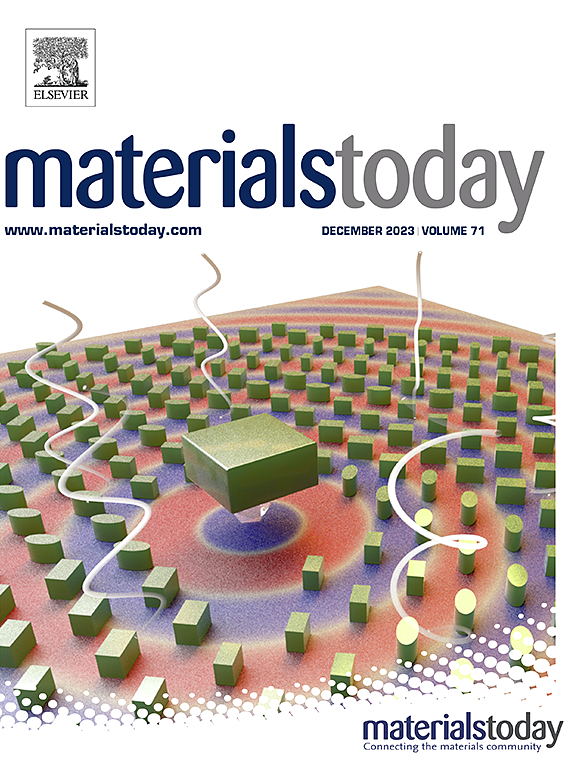Elevating triboelectric polymer charge-carrying capacity via cascaded charge confinement and planting for remarkable performance amplification
IF 21.1
1区 材料科学
Q1 MATERIALS SCIENCE, MULTIDISCIPLINARY
引用次数: 0
Abstract
The attainment of outrageous electrode charge density in triboelectric nanogenerators (TENGs) hinges on substantially strengthening the charge-carrying capacity of triboelectric materials. Here, a universal cistern model is first proposed to derive essential prerequisites for reaching this destination. According to the deduction, surface functionalized BaTiO3 (BTO) nanoparticles and poly(ether-ether-ketone) (PEEK) are exploited to construct interfaces from nanoscale to macroscopic scale in poly (vinylidene fluoride-co-hexafluoropropylene) (P(VDF-HFP)) to immensely bolster its 3D charge confinement capability. Subsequently, through the collaboration of a charge planting module (CPM), the charge hindrance effect is efficaciously attenuated, enabling the modified P(VDF-HFP) to confine more charges. As a consequence, the transferred charge density (TCD) of the TENG utilizing the modified P(VDF-HFP) reaches 600 μC/m2, a 20-fold increment over the TCD of the unmodified P(VDF-HFP). Meanwhile, the charge de-trapping of the modified P(VDF-HFP) also reveals that the CPM not only elevates the surface charge of the dielectric but also raises the space charge of the dielectric, indicative of a synergistic effect between the various tactics. Furthermore, the model and methodology we have crafted can be broadly applied to refine a broad spectrum of triboelectric materials, potentially propelling forward the advancement of highly charged triboelectric dielectrics.
通过级联电荷限制和种植来提高摩擦电聚合物的载电荷能力,从而实现显著的性能放大
摩擦电纳米发电机(TENGs)中极高电极电荷密度的实现取决于摩擦电材料载电荷能力的大幅增强。在这里,首先提出了一个通用的水箱模型,以得出达到这一目标的必要先决条件。根据推断,利用表面功能化的BaTiO3 (BTO)纳米粒子和聚醚-醚酮(PEEK)在聚偏氟乙烯-共六氟丙烯(P(VDF-HFP))中构建了从纳米尺度到宏观尺度的界面,极大地增强了其三维电荷约束能力。随后,通过电荷种植模块(CPM)的协同作用,有效地减弱了电荷阻碍效应,使修饰后的P(VDF-HFP)能够限制更多的电荷。结果表明,使用改性P(VDF-HFP)的TENG的转移电荷密度(TCD)达到600 μC/m2,比未改性P(VDF-HFP)的TCD提高了20倍。同时,改性P(VDF-HFP)的电荷脱陷也揭示了CPM不仅提高了介质的表面电荷,而且提高了介质的空间电荷,表明各种策略之间存在协同效应。此外,我们所设计的模型和方法可以广泛应用于改进广泛的摩擦电材料,有可能推动高电荷摩擦电介质的发展。
本文章由计算机程序翻译,如有差异,请以英文原文为准。
求助全文
约1分钟内获得全文
求助全文
来源期刊

Materials Today
工程技术-材料科学:综合
CiteScore
36.30
自引率
1.20%
发文量
237
审稿时长
23 days
期刊介绍:
Materials Today is the leading journal in the Materials Today family, focusing on the latest and most impactful work in the materials science community. With a reputation for excellence in news and reviews, the journal has now expanded its coverage to include original research and aims to be at the forefront of the field.
We welcome comprehensive articles, short communications, and review articles from established leaders in the rapidly evolving fields of materials science and related disciplines. We strive to provide authors with rigorous peer review, fast publication, and maximum exposure for their work. While we only accept the most significant manuscripts, our speedy evaluation process ensures that there are no unnecessary publication delays.
 求助内容:
求助内容: 应助结果提醒方式:
应助结果提醒方式:


